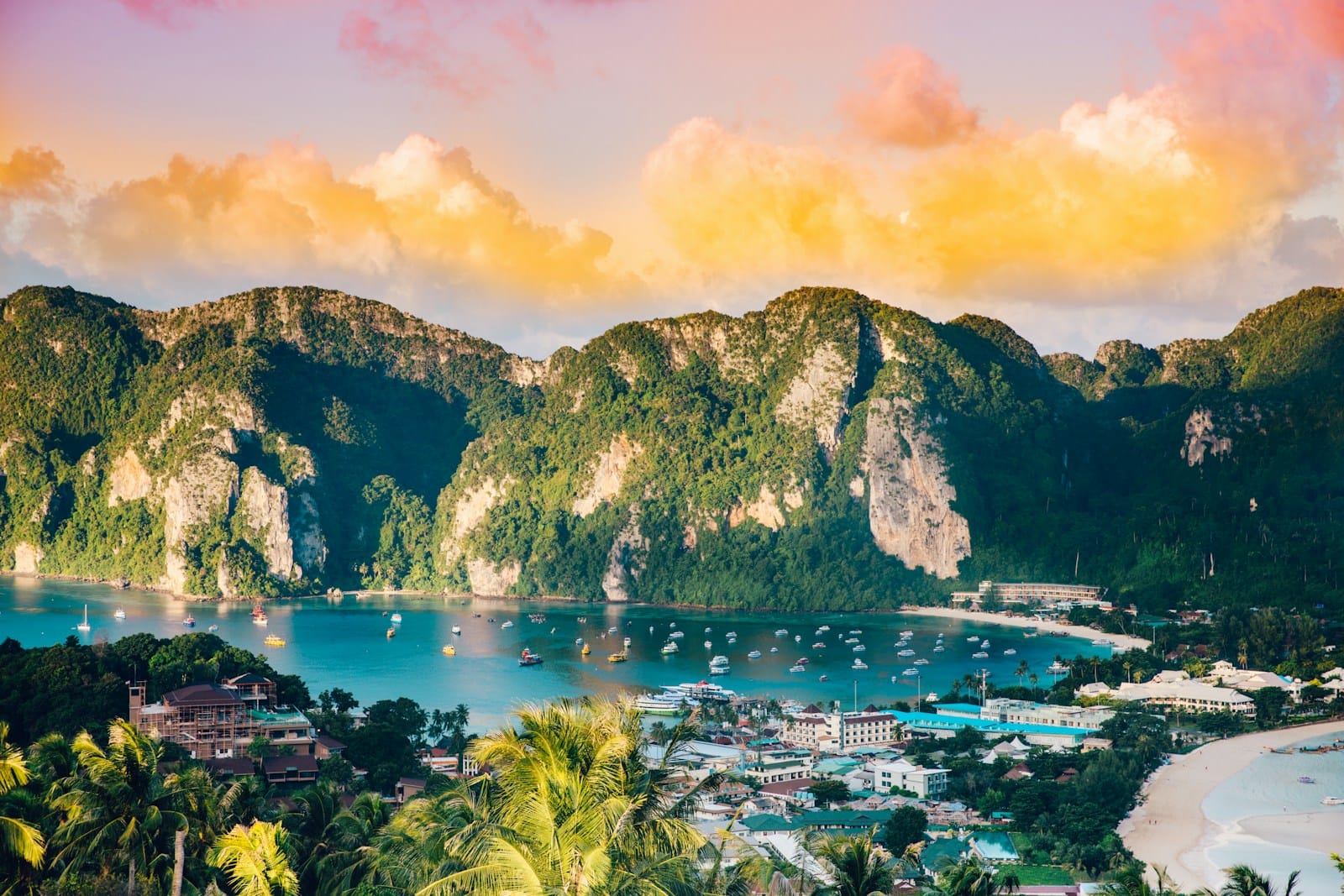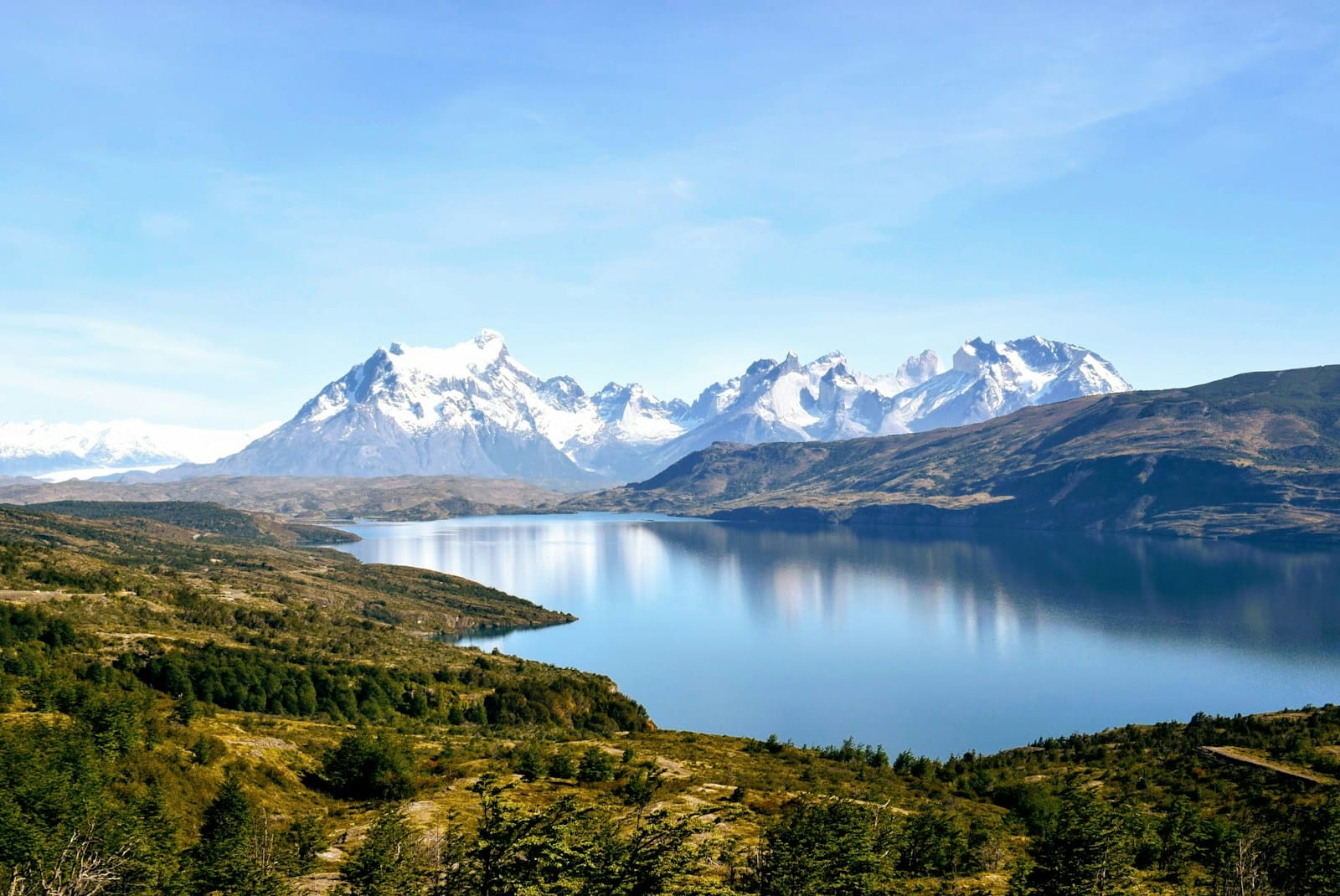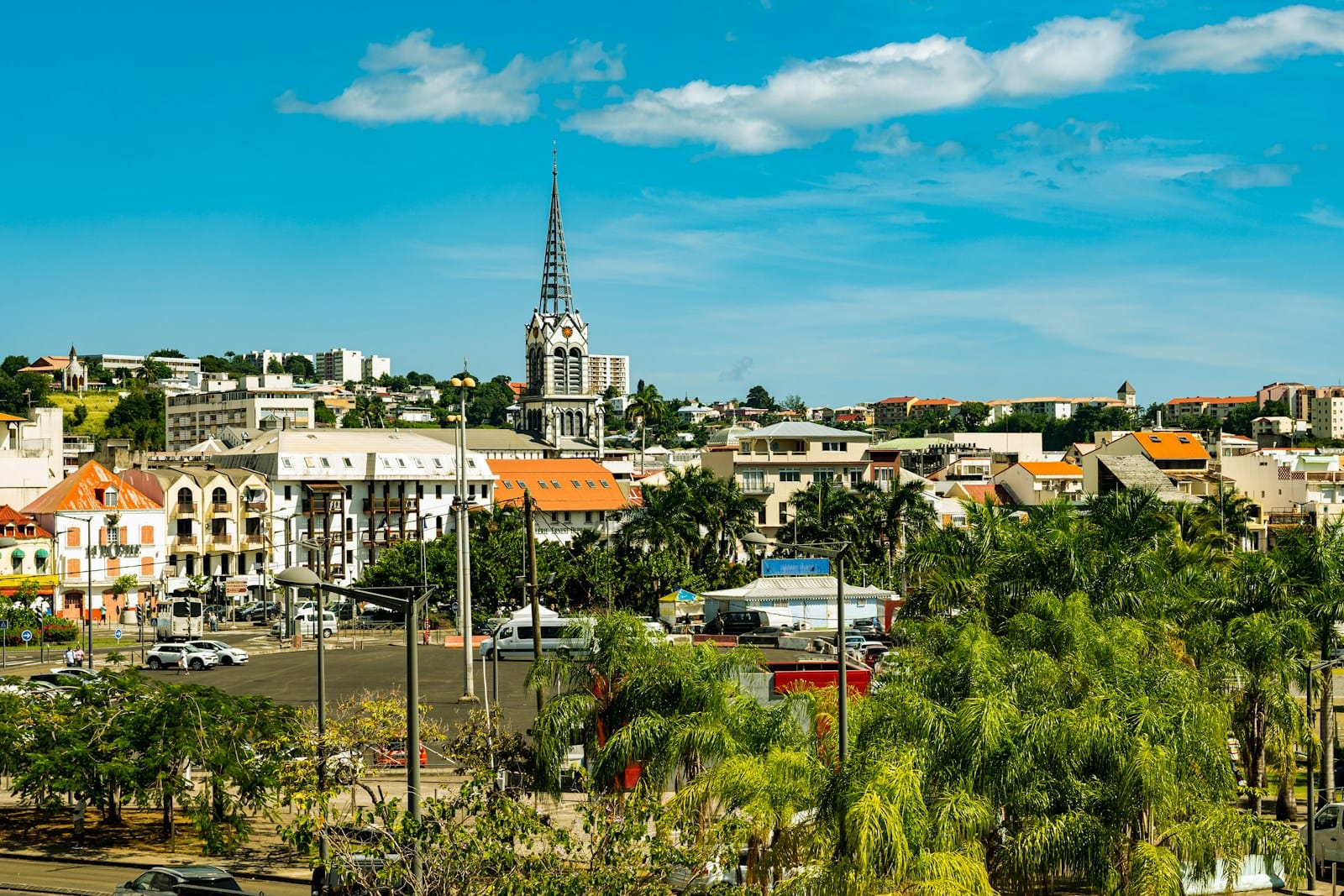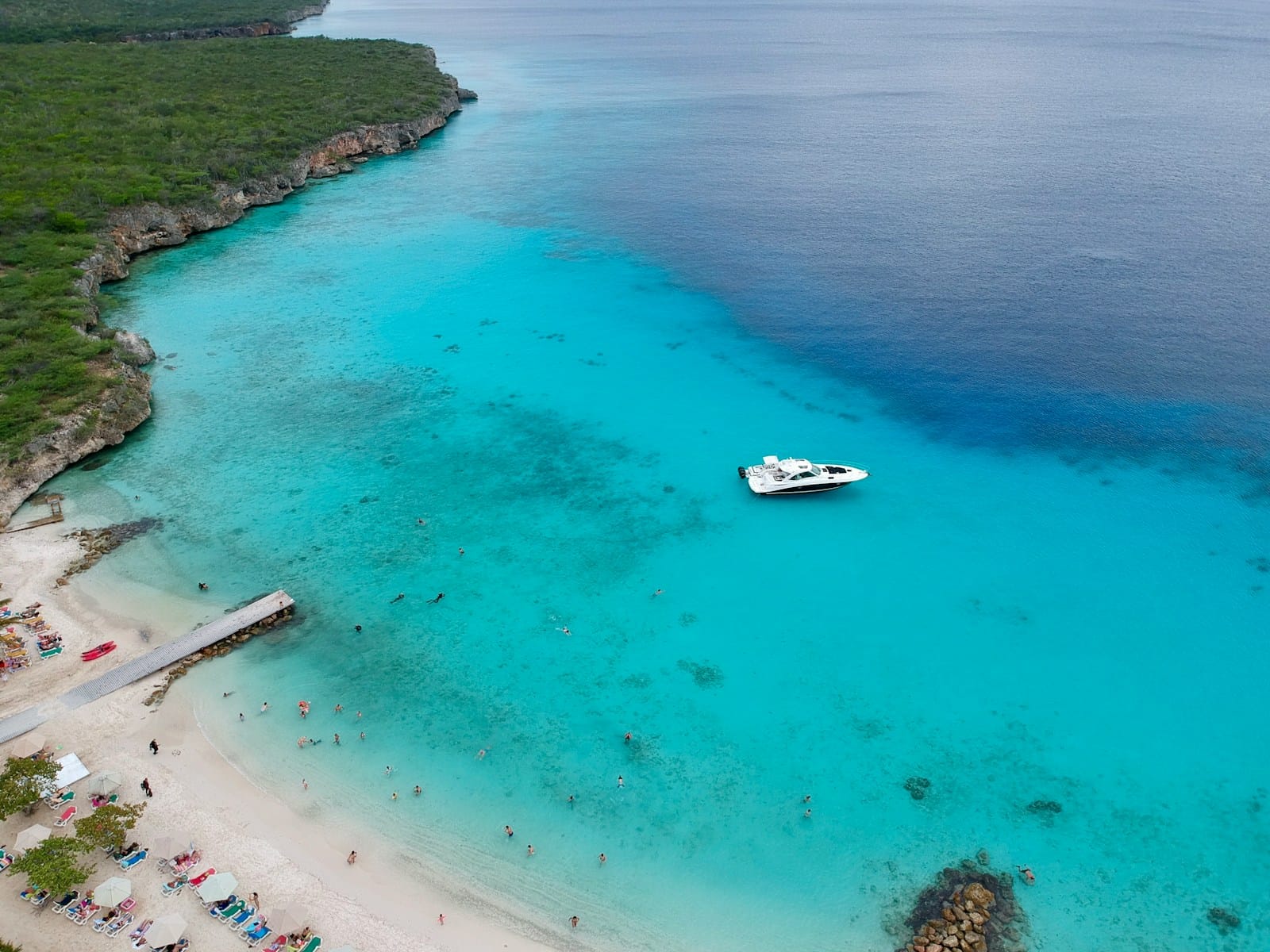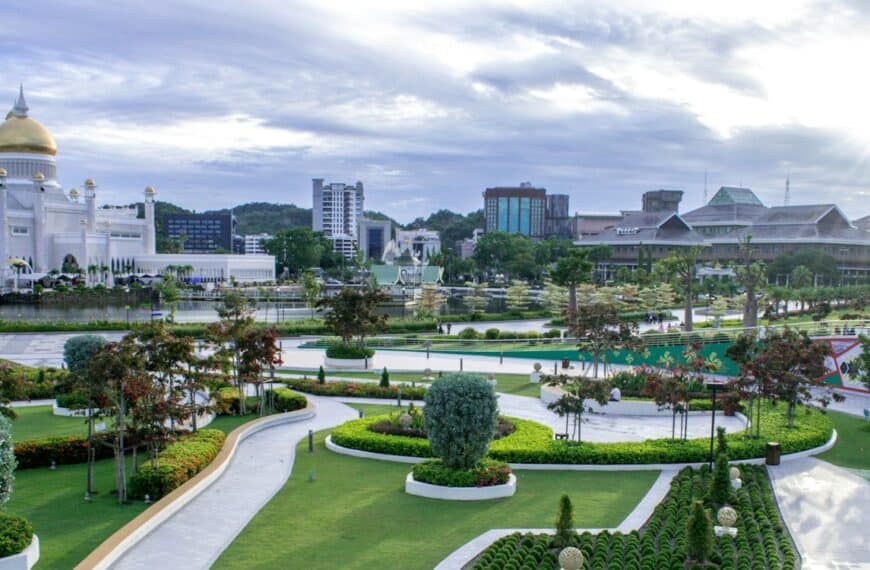Thailand Travel Guide for Beaches, Food and Culture
Intro to Thailand Travel Guide
From jungle-wrapped ruins and northern mountain temples to electrifying markets and postcard-perfect islands, Thailand seduces with its richness of culture, flavors, and scenery. Whether you’re drawn to sacred rituals or street food adventures, this Southeast Asian gem delivers immersive experiences for every kind of traveler — and surprises you at every turn.
Start planning your trip with our complete Thailand Tour Guide — discover golden temples, jungle retreats, vibrant cities, and idyllic beaches in one unforgettable journey.
Travel Destinations in Thailand
Ayutthaya | Bangkok | Chiang Mai | Chiang Rai | Hua Hin | Kanchanaburi | Khao Sok National Park | Krabi | Pai | Pattaya | Phuket | Sukhothai | Trang | Trat | Udon Thani
💡Quick Facts:
Official name: Kingdom of Thailand (ราชอาณาจักรไทย)
Region: Southeast Asia, bordering Myanmar, Laos, Cambodia, and Malaysia
Area: 513,120 km² / 197,255 mi² (National Statistical Office)
Population: ≈ 66 million (2024 est.) (NSO Thailand)
Capital: Bangkok (Krung Thep Maha Nakhon)
Official language: Thai (th); English widely used in tourism
Currency: Thai Baht (THB) (Bank of Thailand)
Time zone: UTC +7 (no daylight saving)
Climate & Known for: Tropical monsoon climate with distinct wet/dry seasons; renowned for beaches, temples, street food, and UNESCO World Heritage sites (Ayutthaya, Sukhothai, Ban Chiang)
Major religion: Theravada Buddhism (~94%) (Office of National Buddhism)
🛂Arrival Info:
Entry requirements: Most visitors receive visa-free entry for 30 days (by air) or 15 days (by land); extendable at immigration offices. Check specific rules by nationality (Thai Immigration Bureau).
eVisa / Visa on Arrival: Available for eligible countries via eVisa Thailand.
Border notes & fees: Land borders with Laos, Cambodia, Myanmar, and Malaysia are generally open to tourists; no official exit tax for air departures.
Customs: Duty-free limits include 200 cigarettes and 1 liter of alcohol; strict bans on vaping devices, e-cigarettes, and certain medications (Thai Customs Department).
🏥Health Info:
Vaccines Required: None for entry
Vaccines Recommended: Routine immunizations, Hepatitis A, Typhoid, Japanese Encephalitis (for rural stays), Rabies (for long-term stays)
Health Risks: Dengue fever, malaria (rural border areas), heat exhaustion, food/water safety issues
Hospitals: Bangkok, Chiang Mai, Phuket have international-standard hospitals (e.g., Bumrungrad International, Bangkok Hospital)
Insurance: Strongly recommended; medical costs high for foreigners
Emergency Number: 1669 (ambulance), 191 (police)
🚑 Check travel insurance options for travel emergencies, delays, and medical needs abroad — Get coverage here
💉 Stay Informed with Official Updates: WHO – International Travel & Health | CDC – Travel health updates
🚨Travel Advisory:
Safety Level: Generally safe; scams and petty theft in tourist zones
Petty Crime: Taxi/tuk-tuk overcharging, jet ski scams, pickpocketing in Bangkok/Phuket
High-Risk Areas: Southern provinces near Malaysian border (insurgency risk)
Natural Risks: Monsoon flooding, rip currents, tropical storms, occasional earthquakes
Civil rights: LGBTQ+ travelers widely accepted socially; same-sex marriage not yet legal (Thai Justice Ministry).
🌍Track Real-Time Official Updates: US Travel Advisory | UK Foreign Travel Advice | Government of Canada | NZ SafeTravel
💰Visitor Info:
Currency use & tipping: Cash dominant outside cities; small tips (10%) common in restaurants and for drivers.
Tourist taxes: Proposed 300 THB entry fee for air arrivals (implementation pending) (Tourism Authority of Thailand).
Payments: Cards widely accepted in urban areas; QR PromptPay used nationwide.
Typical daily budget: Budget US$30–50; Mid-range US$60–120; Luxury US$200+ — coffee ≈ 70 THB, street meal ≈ 60 THB.
🛫Airports:
Suvarnabhumi (BKK) – Bangkok’s main international hub
Don Mueang (DMK) – low-cost carrier hub (AirAsia, Nok Air)
Phuket International (HKT) – gateway to southern islands
Chiang Mai (CNX) – access to Northern Thailand
Krabi (KBV), Koh Samui (USM): Island tourism hubs
Hat Yai (HDY): Southern hub
Domestic airports across Krabi (KBV), Koh Samui (USM), Udon Thani (UTH), and more
🧳 Delayed or canceled flight? Check if you’re eligible for compensation
🚍Transports:
Local transit: Bangkok BTS Skytrain, MRT subway, and BRT — Bangkok Mass Transit Authority. Tuk-tuks and songthaews operate nationwide.
Intercity: Rail network via State Railway of Thailand; buses and domestic flights connect all regions.
Driving: Left-hand traffic; foreign drivers require International Driving Permit and passport.
Ride-hailing: Grab and Bolt available; verify fares before trip.
🚗 Book reliable airport transfers and in-city rides in advance. Reserve your ride here
🛰️Connectivity:
SIM / eSIM: AIS (ais.th), TrueMove (truemoveh.com), and DTAC (dtac.co.th) offer tourist plans at airports.
Network / Wi-Fi: 4G/5G coverage excellent in urban centers; Wi-Fi common in cafés and hotels.
Power: 230 V / 50 Hz; Plug types A, B, and C — adapter recommended for U.S. devices (Electricity Authority of Thailand).
🛜 Stay connected abroad with affordable eSIM data packs. Get your eSIMS here
📜Laws & Etiquette:
Drinking age: 20 years old; alcohol sales banned between 2–5 p.m. and midnight–11 a.m. (Excise Dept.).
Smoking & vaping: Smoking banned in public spaces; vaping illegal (Ministry of Public Health).
Dress & temples: Dress modestly when entering temples or royal grounds; no revealing clothing.
Special legal risks: Severe penalties for drug possession and defamation of the monarchy (lèse majesté law).
👮Safety & Contacts:
Emergency numbers: Police 191 | Ambulance 1669 | Tourist Police 1155 (English support).
Embassies: U.S. Embassy Bangkok | UK Embassy Bangkok.
Lost passport: Report to local police and contact your embassy before visiting Immigration Bureau for replacement.
🗺️US/UK Embassies Abroad: US Embassies | UK Embassies
🏛️ Embassy locator tools: Embassies Worldwide
🌞Weather:
Climate pattern: Tropical — Hot (Mar–Jun avg 33 °C / 91 °F), Rainy (Jul–Oct avg 30 °C / 86 °F), Cool (Nov–Feb avg 27 °C / 81 °F).
Rainfall: 1,200–2,400 mm annually, heaviest in southern provinces.
🌦️Severe weather: Occasional flooding and tropical storms in monsoon season (Thai Meteorological Department).
Thailand by Region – Where to Go
Each region of Thailand brings its own atmosphere, attractions, and signature experiences — from remote highlands to cosmopolitan coasts.
Bangkok & Central Thailand
This region is the cultural and economic heart of Thailand. Bangkok is a sensory overload of royal palaces, canal rides, Michelin-rated street food, and vibrant nightlife. Explore the Grand Palace, Wat Pho, and night markets like Rot Fai. Nearby Ayutthaya, once the ancient capital, offers UNESCO-listed temple ruins perfect for a day trip. Kanchanaburi adds wartime history, floating raft houses, and scenic waterfalls like Erawan Falls.
Northern Thailand
Cooler and more mountainous, the north is steeped in Lanna heritage. Chiang Mai is famous for its temples, night bazaars, and digital nomad scene, while Chiang Rai offers surreal sites like the White Temple and Blue Temple. Pai’s valley is a backpacker favorite, known for hot springs, canyon treks, and motorbike loops. Nature lovers can hike in Doi Inthanon and spot elephants at ethical sanctuaries.
Northeastern Thailand (Isan)
Thailand’s largest but least-visited region is perfect for cultural explorers. Isan is known for its spicy cuisine, Khmer temples, and warm rural hospitality. Highlights include Phanom Rung Historical Park, the Mekong River views from Nakhon Phanom, and festivals like Bun Bang Fai (Rocket Festival). Expect fewer tourists and more authentic village life.
Eastern Thailand
Eastern Thailand is ideal for beach escapes within driving distance of Bangkok. Pattaya blends entertainment, nightlife, and water sports. Quieter islands like Ko Samet and Ko Chang deliver white-sand beaches and jungle adventures without airport transfers. Inland, Chanthaburi is famous for gem markets and fruit orchards, especially during rambutan and durian season.
Southern Thailand (Andaman Coast)
This region boasts some of Thailand’s most dramatic coastal scenery. Phuket offers luxury resorts, lively beach towns, and a jumping-off point to islands like Ko Phi Phi. Krabi’s Ao Nang and Railay Beach offer limestone cliffs, kayaking, and sea caves. Don’t miss Ko Lanta for a slower island vibe or Phang Nga Bay for James Bond-style scenery.
Southern Thailand (Gulf Coast)
The Gulf side brings sun-soaked islands with calmer waters. Ko Samui combines upscale resorts and nightlife with waterfalls and temples. Ko Pha Ngan is famous for its Full Moon Parties, but the northern beaches are peaceful and serene. Ko Tao is a diving haven, ideal for beginners and budget travelers. Inland, Surat Thani provides transit hubs and national parks like Khao Sok.
Top Places to Visit in Thailand
From ancient capitals to remote beaches, Thailand is packed with destinations to match any travel dream.
Cultural Capitals
- Bangkok – Visit gilded temples, royal sites, and lively markets.
- Chiang Mai – Temple-hop, join a monk chat, and explore hill tribe villages.
- Ayutthaya – Discover atmospheric ruins just north of the capital.
Island Escapes
- Ko Phi Phi – Dive into turquoise bays and climb to the iconic viewpoint.
- Ko Lanta – Peaceful beaches, mangrove forests, and family-friendly vibes.
- Ko Tao – One of Asia’s best-value scuba diving training spots.
Nature & Wildlife
- Khao Sok National Park – Float on emerald lakes and sleep in jungle lodges.
- Doi Inthanon – Hike Thailand’s highest peak and visit Karen villages.
- Elephant Nature Park – A sanctuary near Chiang Mai with ethical animal care.
Historic Sites & Sacred Spaces
- Sukhothai Historical Park – Cycle among ancient Buddha statues and moats.
- Phanom Rung – A Khmer-style mountaintop temple near the Cambodian border.
- Wat Pho – Home of the Reclining Buddha and Thai massage school.
Off-the-Beaten-Path Gems
- Mae Hong Son – A mountainous loop with temples, caves, and hill tribe markets.
- Nong Khai – Mekong River sunsets and surreal Buddhist sculpture gardens.
- Trang Islands – Lesser-known beaches, seafood villages, and emerald caves.
How to Choose Where to Go in Thailand
With so many options, your travel goals help determine the best Thai itinerary.
- For Culture & Temples: Focus on Chiang Mai, Ayutthaya, Bangkok, and Sukhothai for deep heritage and artistic architecture.
- For Islands & Beaches: Head to Phuket or Krabi for variety, or pick Ko Lanta and Ko Yao for serenity. Ko Samui and Ko Tao shine for luxury and diving.
- For Food Adventures: Bangkok is unbeatable, but also try Isan street food in Ubon Ratchathani or Chiang Mai’s northern specialties.
- For Nature & Wildlife: Explore Doi Inthanon, Khao Sok, and ethical elephant sanctuaries around Chiang Mai.
Efficient Pairings:
- Bangkok + Ayutthaya (culture + history)
- Chiang Mai + Pai (mountains + chill)
- Phuket + Ko Phi Phi (beaches + diving)
- Ko Samui + Khao Sok (island + jungle retreat)
How to Get Around Thailand
Thailand’s infrastructure makes travel smooth, whether you’re island-hopping or train trekking.
- Domestic Flights
Budget carriers like AirAsia and Nok Air connect major cities and islands. Book early for cheap fares — especially during holidays. - Trains
Comfortable and scenic, the train is great for long-distance routes like Bangkok to Chiang Mai or Nong Khai. Sleeper trains offer air-conditioned berths. - Long-Distance Buses
Extensive and reliable, buses reach almost every region. Use government-operated buses or trusted lines like Nakhonchai Air. - Ferries & Boats
Essential for island travel, ferries run between Ko Samui, Ko Tao, Ko Phi Phi, and Krabi. Buy combo tickets (bus + ferry) for efficiency. - Taxis, Tuk-Tuks & Ride Apps
In cities, Grab (Thailand’s Uber equivalent) is reliable and transparent. Tuk-tuks are iconic but negotiate first. Songthaews (shared trucks) serve smaller towns. - Car & Scooter Rentals
Scooters are popular in Chiang Mai, Pai, and the islands — but drive defensively. International Driver’s Permit is legally required. - Travel Apps
Use 12Go Asia for tickets, Grab for transport, and Google Translate for local signs and conversations.
Travel Budget & Costs in Thailand
Thailand caters to all budget levels — you can travel affordably or splurge in style.
Average Daily Costs
- Budget: $25–40 (hostels, street food, buses)
- Mid-range: $60–120 (hotels, guided tours, ferries)
- Luxury: $150–400+ (resorts, private transfers, fine dining)
Sample Prices
- Street meal: $1–2
- Sit-down Thai meal: $3–6
- Intercity bus: $7–15
- Hostel bed: $8–15
- Mid-range hotel: $35–80
- Island ferry: $10–25
- Massage: $6–15 per hour
Money-Saving Tips
- Buy SIM cards or eSIMs for cheap data (DTAC, AIS).
- Eat where locals eat — food courts and markets.
- Use public transport and shared taxis.
- Travel in shoulder season (May–June, Sept–Oct).
Best Time to Visit Thailand
Thailand’s weather varies significantly by region, but you can enjoy the country year-round by planning smartly.
Cool & Dry Season (Nov–Feb)
The most popular time to visit — perfect weather across the country. Expect mild temperatures in the north and ideal beach weather in the south. It’s also festival season, including Loy Krathong and Chiang Mai Flower Festival.
Hot Season (Mar–May)
Temperatures soar, especially in Bangkok and Isan. A great time for coastal travel if you can handle the heat. Songkran (Thai New Year) in April is a nationwide water fight and cultural event not to be missed.
Rainy Season (Jun–Oct)
Daily showers (mostly in the afternoon) make landscapes lush and waterfalls full. The Andaman side sees heavier rain, while the Gulf islands like Ko Samui are relatively dry through early September. Fewer crowds and great deals.
Best time to visit Thailand:
- For beaches: December to March
- For trekking: November to February
- For festivals: April and November
- For diving: January to April (Andaman), June to Sept (Gulf)
Must-See Experiences in Thailand
These unforgettable activities showcase the country’s spirit — from sacred rituals to culinary deep dives.
Cultural Encounters & Temples
- Witness morning almsgiving in Luang Prabang
- Explore the Grand Palace and Emerald Buddha
- Visit the White Temple and Black House in Chiang Rai
- Meditate in a forest monastery near Chiang Mai
Food Markets & Thai Cooking
- Feast on grilled satay, som tam, and mango sticky rice at Chiang Mai’s Night Bazaar
- Cruise Bangkok’s floating markets
- Join a cooking class to master green curry or pad Thai
- Sip Thai milk tea at Chatuchak weekend market
Outdoor Adventures
- Kayak through limestone karsts in Phang Nga Bay
- Snorkel or dive in Ko Tao’s coral gardens
- Hike to Doi Pha Hom Pok National Park’s summit
- Rock climb at Railay Beach
Festivals & Sacred Events
- Join the mass lantern release during Yi Peng in Chiang Mai
- Dance at the Full Moon Party on Ko Pha Ngan
- Attend Ubon Ratchathani Candle Festival
- Experience the colorful Phuket Vegetarian Festival
Discover authentic Thailand tours and dive into the best things to do in Thailand — from temple ceremonies and mountain hikes to floating markets and lakeside culinary experiences. We may earn a commission if you book through our links — at no additional cost to you.
Best Travel Itineraries in Thailand
3-Day Itinerary
- Day 1: Arrive in Bangkok and explore the Grand Palace, Wat Pho, and take a riverboat ride along the Chao Phraya. In the evening, sample street food at Yaowarat (Chinatown).
- Day 2: Take a day trip to Ayutthaya’s UNESCO-listed ruins. Return to Bangkok for rooftop cocktails and night markets.
- Day 3: Spend the morning shopping at Chatuchak Market or visiting Jim Thompson House before departure.
5-Day Itinerary
- Day 1: Begin in Bangkok with temples, a canal tour, and street food tasting.
- Day 2: Fly to Chiang Mai, explore the Old City temples, and enjoy the vibrant night bazaar.
- Day 3: Visit Doi Suthep temple in the morning and spend the afternoon at an ethical elephant sanctuary.
- Day 4: Join a cooking class, then relax with a Thai massage and evening market stroll.
- Day 5: Fly back to Bangkok or connect southward for onward flights.
7-Day Itinerary
- Day 1: Explore Bangkok’s highlights including the Grand Palace and river cruises.
- Day 2: Day trip to Ayutthaya’s ancient ruins with a local guide.
- Day 3: Fly to Chiang Mai, discover its temples and bustling night market.
- Day 4: Hike in Doi Inthanon National Park, visiting waterfalls and hill tribe villages.
- Day 5: Visit an elephant sanctuary and relax in the afternoon with spa treatments.
- Day 6: Fly south to Phuket, unwind on Kata Beach, and enjoy a seafood dinner.
- Day 7: Take a boat excursion to Phang Nga Bay or the Phi Phi Islands before departure.
10-Day Itinerary
- Day 1: Arrive in Bangkok, tour temples, and enjoy a tuk-tuk street food tour.
- Day 2: Explore more of Bangkok’s neighborhoods, markets, and the Jim Thompson House.
- Day 3: Take a full-day excursion to Ayutthaya.
- Day 4: Fly north to Chiang Mai, explore Old City temples, and night bazaars.
- Day 5: Visit Doi Suthep, then relax at local markets and cafes.
- Day 6: Spend the day at an ethical elephant sanctuary or trekking nearby hills.
- Day 7: Fly to Phuket and relax on Patong, Kata, or Karon beaches.
- Day 8: Island-hop to Ko Phi Phi for snorkeling and lagoon swims.
- Day 9: Day trip to Phang Nga Bay with kayaking among limestone cliffs.
- Day 10: Enjoy your final morning at the beach or a spa before departure.
Local Cuisine & Culinary Experiences
Thailand’s food scene is as diverse as its regions — from fiery Isan dishes to royal cuisine.
Must-Try Dishes
- Pad Thai – Stir-fried noodles with egg, tofu, and tamarind
- Tom Yum Goong – Spicy lemongrass shrimp soup
- Khao Soi – Creamy northern noodle curry with crispy toppings
- Som Tam – Pounded green papaya salad with lime and chili
- Massaman Curry – Rich Muslim-style curry with potatoes and peanuts
- Moo Ping – Grilled pork skewers often eaten with sticky rice
- Gaeng Keow Wan – Fragrant green curry with basil and eggplant
- Kanom Krok – Coconut rice pancakes from roadside stalls
Food Adventures to Try
- Join a Bangkok street food tour
- Dine at a floating market in Amphawa or Taling Chan
- Visit Chiang Mai’s Warorot Market
- Try bug snacks in Khao San Road (if you dare!)
- Tour a coconut farm in Samut Songkhram
Where to Base Yourself in Thailand
- Bangkok, Chiang Mai, and Phuket serve as major tour gateways with diverse lodging—from riverside boutiques to beachfront resorts.
- Base in Bangkok for easy access to national rail lines and domestic flights.
- Northern hubs like Chiang Mai and Pai offer culture-rich stays near trekking and temple tours.
- Southern islands such as Krabi and Koh Samui combine beach relaxation with quick tour departures.
→ Where to Stay in Thailand
Travel Safety & Cultural Etiquette in Thailand
Thailand is generally safe, but cultural respect and awareness go a long way.
General Safety Tips
- Beware of overcharging tuk-tuks and gem scams in tourist areas
- Stick to licensed tour operators and avoid animal tourism
- Respect curfews or rules during royal or national events
- Wear helmets on scooters, especially in hilly or island regions
Health & Hygiene
- Tap water isn’t drinkable — buy bottled or refill at filtered stations
- Mosquito repellent is essential in rural and island areas
- Pack Imodium and basic meds (pharmacies are everywhere)
- Use reef-safe sunscreen for beach and dive trips
Cultural Do’s and Don’ts
- Always remove shoes before entering a temple or home
- Dress modestly when visiting temples (shoulders and knees covered)
- Avoid touching anyone’s head (considered sacred)
- Don’t point your feet at people or Buddha images
- Wai (palms together) as a respectful Thai greeting
- Learn a few Thai phrases — even “sawasdee ka/krap” goes a long way
Keep Exploring with These Picks
- Bangkok Tours & Excursions
- Chiang Mai Tours & Excursions
- Phuket Tours & Excursions
- Krabi Tours & Excursions
- Ko Phi Phi Tours & Excursions
- Ko Phi Phi Le Tours and Tickets
- Chiang Rai Tours & Excursions
If you book through our links, we may earn a commission — but you won’t pay extra.
Continue Your Journey Beyond Thailand
- Laos – Just across the Mekong, Laos offers a slower pace with river cruises, Buddhist temples, and stunning natural landscapes. Luang Prabang’s saffron-robed monks, waterfalls, and French-colonial charm make it a serene contrast to Thailand’s bustling cities. Vientiane and the 4,000 Islands region add layers of culture and tranquility.
- Cambodia – Combine your Thai journey with Cambodia’s Angkor Wat, one of the world’s most impressive archaeological complexes. Phnom Penh offers poignant history at the Killing Fields and Royal Palace, while coastal towns like Kep and Kampot provide laid-back escapes. Overland travel from Bangkok to Siem Reap is straightforward.
- Vietnam – A few hours by flight, Vietnam dazzles with its mix of Hanoi’s Old Quarter, Ha Long Bay cruises, and Ho Chi Minh City’s bustling energy. Food lovers will find street eats like pho and banh mi irresistible. Pairing Thailand with Vietnam lets you experience two distinct yet complementary Southeast Asian cultures.
- Malaysia – South of Thailand, Malaysia blends modern Kuala Lumpur skyscrapers with UNESCO-listed George Town in Penang. Langkawi and Perhentian Islands offer beaches and diving that rival Thailand’s, while Cameron Highlands provide cool tea plantation landscapes. It’s an easy extension by air or even overland through southern Thailand.
- Myanmar (Burma) – For travelers seeking more off-the-beaten-path experiences, Myanmar reveals golden temples, Bagan’s pagoda-dotted plains, and Inle Lake’s floating villages. Border crossings with Thailand connect adventurous routes, though most opt to fly into Yangon or Mandalay. Pairing both countries deepens your understanding of Buddhist traditions and Southeast Asian heritage.
Final Planning Checklist for Thailand
Make sure you’re fully prepped before takeoff with this essential action list:
- Finalize your itinerary — regions, islands, and travel flow
- Book key hotels, domestic flights, and ferries early in high season
- Apply for a Thai tourist visa if needed (most countries get 30 days)
- Download offline Google Maps and translation apps
- Arrange an eSIM or buy a local SIM at the airport (AIS, TrueMove, DTAC)
- Carry modest outfits for temple visits and rural areas
- Pack lightweight clothing, mosquito repellent, and sunscreen
- Back up documents digitally and carry a few paper copies
- Review customs for temples, greetings, and local tipping
Explore Thailand with confidence using our trusted tips, local insights, and region-by-region planning tools. For more expert travel tips, practical strategies, and trusted tools — visit our Homepage and get inspired for your next trip.

